|
Antique and Vintage Jewelry
|
|
 |
|
 |
|

Price :
Contact Dealer
For over a thousand years, successive generations of Venetian glass artisans have passed their ancient handcraft down from master to apprentice. Even today in Venice, the art More »
For over a thousand years, successive generations of Venetian glass artisans have passed their ancient handcraft down from master to apprentice. Even today in Venice, the art of hand fusing molten glass into beautiful multi-colored beads continues in the traditional manner. The Venetians produced many colorful designs, which were traded with African tribes for important items such as gold, ivory, and even slaves. This was definitely a study in relative value, since Western culture considered gold, for instance, much more valuable than the glass beads that they could produce in mass quantities. However, to the tribes of sub-Saharan Africa, these colorful beads became important components in both their rituals and personal adornment. Natural resources were plentiful on the African continent, but methods to produce the beautiful glass beads they desired were not. Thus these beads, like shells, became a form of currency recognized throughout the continent. Beads were desired both for their aesthetic beauty, as well as their rarity. When one considers that these beads might have been traded for their weight in gold, their true value to the Africans becomes clear. These were luxury item, manufactured and transported from exotic, far away lands. Such necklaces could only be afforded by the very wealthy, which often limited their ownership to kings, tribal chiefs, and their courts. Holding this necklace in our hands, we feel a weight and presence that is surely befitting of a king. We can imagine an annual ceremony perform long ago under the African sun, drums banging, dancers moving to the rhythms, when through the parted crowd descends a king dressed in the most elaborate, luxurious garments: gold rings and sandals, robes featuring European and Middle Eastern clothes, and a necklace made of thick colored Venetian beads. - (PF.6140)Origin: Venice, Italy Circa: 16 th Century AD to 18 th Century AD Collection: Jewelry Style: Venetian Trade Beads Medium: Glass Beads « Less
|
|
Antique Jewelry
|
|
|
|
|
| Vendor Details |
Close |
| Contact Info : |
| Barakat Gallery |
| 405 North Rodeo Drive |
| Beverly Hills |
| California-90210 |
| USA |
| Email : barakat@barakatgallery.com |
| Phone : 310.859.8408 |
|
|
|
|
|
|

Price :
Contact Dealer
For over a thousand years, successive generations of Venetian glass artisans have passed their ancient handcraft down from master to apprentice. Even today in Venice, the art More »
For over a thousand years, successive generations of Venetian glass artisans have passed their ancient handcraft down from master to apprentice. Even today in Venice, the art of hand fusing molten glass into beautiful multi-colored beads continues in the traditional manner. The Venetians produced many colorful designs, which were traded with African tribes for important items such as gold, ivory, and even slaves. This was definitely a study in relative value, since Western culture considered gold, for instance, much more valuable than the glass beads that they could produce in mass quantities. However, to the tribes of sub-Saharan Africa, these colorful beads became important components in both their rituals and personal adornment. Natural resources were plentiful on the African continent, but methods to produce the beautiful glass beads they desired were not. Thus these beads, like shells, became a form of currency recognized throughout the continent. Beads were desired both for their aesthetic beauty, as well as their rarity. When one considers that these beads might have been traded for their weight in gold, their true value to the Africans becomes clear. These were luxury item, manufactured and transported from exotic, far away lands. Such necklaces could only be afforded by the very wealthy, which often limited their ownership to kings, tribal chiefs, and their courts. Holding this necklace in our hands, we feel a weight and presence that is surely befitting of a king. We can imagine an annual ceremony perform long ago under the African sun, drums banging, dancers moving to the rhythms, when through the parted crowd descends a king dressed in the most elaborate, luxurious garments: gold rings and sandals, robes featuring European and Middle Eastern clothes, and a necklace made of thick colored Venetian beads. - (PF.6141)Origin: Venice, Italy Circa: 16 th Century AD to 18 th Century AD Collection: Jewelry Style: Venetian Trade Beads Medium: Glass and Beads « Less
|
|
Antique Jewelry
|
|
|
|
|
| Vendor Details |
Close |
| Contact Info : |
| Barakat Gallery |
| 405 North Rodeo Drive |
| Beverly Hills |
| California-90210 |
| USA |
| Email : barakat@barakatgallery.com |
| Phone : 310.859.8408 |
|
|
|
|
|
|

Price :
$1200.00
This necklace is composed of genuine antique Venetian glass trade beads and modern peridot beads. During the late Middle Ages and throughout the Renaissance, Venetian More »
This necklace is composed of genuine antique Venetian glass trade beads and modern peridot beads. During the late Middle Ages and throughout the Renaissance, Venetian artisans rediscovered the ancient secrets of glass making. On the island of Murano, they created superb vessels and jewelry which were valued throughout the known world. It was also during this period that Venice became the most powerful trading nation in Europe, a city whose ships visited every port both east and west. Venetian traders used glass beads for barter, and these jewels became especially prized in Africa, where they were traded for gold, ivory, rare woods and spices. Venetian beads quickly became a medium of exchange throughout Africa, and in some tribes were used as a bridal dowry. Origin: Venice Circa: 17 th Century AD to 18 th Century AD Collection: Jewelry Style: Venetian Beaded Necklaces Medium: Glass and Peridot « Less
|
|
Antique Jewelry
|
|
|
|
|
| Vendor Details |
Close |
| Contact Info : |
| Barakat Gallery |
| 405 North Rodeo Drive |
| Beverly Hills |
| California-90210 |
| USA |
| Email : barakat@barakatgallery.com |
| Phone : 310.859.8408 |
|
|
|
|
|
|

Price :
$180.00
The delicate, lustrous beauty of the pearl has captured the imagination of men and women since the dawn of time. This gorgeous gem is formed when an irritant becomes trapped More »
The delicate, lustrous beauty of the pearl has captured the imagination of men and women since the dawn of time. This gorgeous gem is formed when an irritant becomes trapped inside the shell of a mollusk, and a protective coating of nacre is formed around the object. Pearls are one of the few jewelry items to remain continuously in fashion through the centuries. It is easy to see why. They delight the eye and flatter the wearer, a true gift from nature. For centuries, coral-- like pearl, a gift of the sea-- was classed among the precious gems valued by man. Not strictly a mineral, coral is an organic substance, composed of the skeletons of millions of tiny marine animals. In its natural state, coral is plantlike in appearance and grows in warm water at depths of up to ninety feet. In hue, it varies from white, to pink, to red or orange, to black. Coral jewelry is known from the Egyptian, Biblical, Classical and Islamic periods. Coral is used as a heart stimulant, as an antidote for fevers and toxins in the body, and for preventing vomiting, colic, and childhood diseases. Its mysterious strength seems to derive from its organic source material, the accumulated energy of living things. Collection: Jewlery Style: Beaded Necklaces Medium: Freshwater Pearls « Less
|
|
Vintage Jewelry
|
|
|
|
|
| Vendor Details |
Close |
| Contact Info : |
| Barakat Gallery |
| 405 North Rodeo Drive |
| Beverly Hills |
| California-90210 |
| USA |
| Email : barakat@barakatgallery.com |
| Phone : 310.859.8408 |
|
|
|
|
|
|
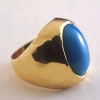
Price :
$2579.00
A gem of celestial blue beauty, turquoise ("the Turkish stone") has been prized as adornment and sought after as a talisman throughout the ages and all over the world. A More »
A gem of celestial blue beauty, turquoise ("the Turkish stone") has been prized as adornment and sought after as a talisman throughout the ages and all over the world. A complex phosphate of aluminum and copper, which ranges in color from bright blue to green to gray, turquoise is mined mostly in arid regions with sedimentary and fractured volcanic rocks. The Pharaohs of Egypt left inscriptions recording their successful turquoise mining in the Sinai desert, while the Indians of the American Southwest--who considered it a sacred stone-- found their sources chiefly in New Mexico and Arizona. Turquoise occurs in a wide area of the Near East and Europe, and its use in jewelry and amulets dates from the 5th millennium before Christ. The Egyptians particularly valued it as a bringer of luck, in which capacity it is still used throughout the Middle East. In the Americas, it was considered an essential possession for a medicine man, and was used extensively as adornment, as it still is today. Ancient Indian burial sites have yielded up thousands of turquoise beads used to decorate the deceased. Its power as a charm of good fortune is thought to be unrivaled because of its lucky blue color; it is believed to protect the wearer from accidents and falls. Therapeutically, the gem is useful for freeing the body from toxins, preventing arthritis, curing eye diseases, and relieving urinary disorders. To wear turquoise is to wear the sky on a bright and sunny day. - (FJ.2853)Origin: Arizona Collection: Modern Jewelry Medium: Turquoise and Gold « Less
|
|
Contemporary Designs
|
|
|
|
|
| Vendor Details |
Close |
| Contact Info : |
| Barakat Gallery |
| 405 North Rodeo Drive |
| Beverly Hills |
| California-90210 |
| USA |
| Email : barakat@barakatgallery.com |
| Phone : 310.859.8408 |
|
|
|
|
|
|
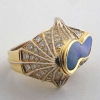
Price :
Contact Dealer
This genuine Australian Boulder opal weighs 5.86 carats and has been set in a modern 18 karat gold and platinum ring embellished with 137 genuine fully-cut diamonds weighing More »
This genuine Australian Boulder opal weighs 5.86 carats and has been set in a modern 18 karat gold and platinum ring embellished with 137 genuine fully-cut diamonds weighing a total of 3.99 carats. Radiating a colorful fire from deep within, the opal has been prized since antiquity. Within its depths one sees the rich variety of colors for which other gems are famed: the purple of amethyst, the red of ruby, the sea green of emerald, as well as gold and silver. The matrix for these sparks ranges in hue from milky white to bright blue to black. Mines in Hungary have produced fine opals since the Middle Ages, but the best modern source for the gem is considered to be Australia. The name of the gem is said to derive from the word ophthalmius, pertaining to the eye, and the stone is valued for its ability to avert evil. In the East, opals are much sought after as amulets to protect the wearer from disease. The stone is also said to improve the eyesight. Any person gazing upon this brilliant gem will be rewarded with beauty. Origin: Australia and South Africa Collection: Modern Jewelry Style: Gem Stone Rings Medium: Boulder Opal, Gold « Less
|
|
Contemporary Designs
|
|
|
|
|
| Vendor Details |
Close |
| Contact Info : |
| Barakat Gallery |
| 405 North Rodeo Drive |
| Beverly Hills |
| California-90210 |
| USA |
| Email : barakat@barakatgallery.com |
| Phone : 310.859.8408 |
|
|
|
|
|
|
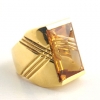
Price :
$4200.00
Citrine weighing 14.37 carats set in an 18 karat gold ring. Named after the lemon for its rich yellow to orange/brown coloring, citrine is a member of the quartz family. It More »
Citrine weighing 14.37 carats set in an 18 karat gold ring. Named after the lemon for its rich yellow to orange/brown coloring, citrine is a member of the quartz family. It was frequently used in Hellenistic and Roman times for rings, intaglios and other jewelry. Though its primary source in Antiquity, as now, was Ceylon, deposits are also known in Spain and the Ural Mountains. Metaphysical science values citrine for its transformative energy, which is thought to raise low vibrations to a higher level, making it useful for healing and meditation. Citrine is also considered as a lucky talisman to bring success in all business ventures. In addition to its curative and soothing properties, its warm, glowing color brings pleasure to the senses. - (FJ.4975)Origin: Brazil Circa: 20 th Century AD Collection: Modern Jewelry Style: Contemporary Medium: Citrine and Gold « Less
|
|
Contemporary Designs
|
|
|
|
|
| Vendor Details |
Close |
| Contact Info : |
| Barakat Gallery |
| 405 North Rodeo Drive |
| Beverly Hills |
| California-90210 |
| USA |
| Email : barakat@barakatgallery.com |
| Phone : 310.859.8408 |
|
|
|
|
|
|
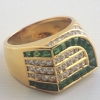
Price :
$9600.00
Radiant 18 karat gold ring set with 21 faceted emeralds weighing a total of 1.28 carats and 27 fully-cut diamonds weighing a total of 1.43 carats. Perhaps no gem delights the More »
Radiant 18 karat gold ring set with 21 faceted emeralds weighing a total of 1.28 carats and 27 fully-cut diamonds weighing a total of 1.43 carats. Perhaps no gem delights the senses in quite the same way as the diamond, which burns with a deep internal fire. Crystalized carbon, formed under tremendous pressure over millennia, the diamond is famed for its everlasting hardness. Diamonds are normally colorless, but are also found in shades including yellow, pink, and blue. In Eastern belief, the diamond is said to enhance the full spectrum of energies in the body, mind and spirit. Within the circle of gems, the diamond defines the standards of beauty, rarity, and preciousness. A deep green member of the beryl family, the emerald is the rarest of the so called precious gems. Though sources for emeralds are found in both the old and new worlds, a stone of good quality is still an elusive object. Emeralds without a flaw are almost unattainable, as the gem exhibits many natural inclusions, but these do not necessarily mar the stone’s intense green beauty. The famous queen Cleopatra of Egypt mined emeralds near Zabara on the red sea coast in the first century B.C., wearing the jewels herself or giving them as gifts to favored friends. Julius Caesar particularly valued the gem, to which he ascribed strong curative powers. Emeralds were found in the buried roman cities of Pompeii and Herculaneum, which probably came originally from Egypt. In Meso America, emeralds were treasured by the native cultures, most particularly the Incas who worshiped them as sacred. When the Spanish conquistadors plundered the Inca Empire for gold and jewels, many remarkable large emeralds were taken to Europe, where they entered the treasuries of courts. Today, the major source for emeralds is South America and especially Colombia, where mines first worked by the Pre-Columbian cultures are still in use. The rarity of the emerald has always made it a valuable and potent talisman. It is said to cure diseases of the eye, free the body from poisons, arrest physical decay of all sorts, stop dysentery, facilitate childbirth and end attacks of epilepsy. The bright green of this gem makes it as desirable today as it has always been throughout the ages. - (FJ.5014)Origin: Colombia/ South Africa Collection: Jewelry Style: Contemporary Medium: Emerald-Diamond-Gold « Less
|
|
Contemporary Designs
|
|
|
|
|
| Vendor Details |
Close |
| Contact Info : |
| Barakat Gallery |
| 405 North Rodeo Drive |
| Beverly Hills |
| California-90210 |
| USA |
| Email : barakat@barakatgallery.com |
| Phone : 310.859.8408 |
|
|
|
|
|
|
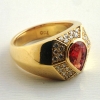
Price :
$11609.00
Stunning 18 karat gold ring set a beautiful pear- shaped ruby weighing 1.86 carats and 34 radiant fully-cut diamonds weighing a total of 0.62 carats. Ruby is the red variety More »
Stunning 18 karat gold ring set a beautiful pear- shaped ruby weighing 1.86 carats and 34 radiant fully-cut diamonds weighing a total of 0.62 carats. Ruby is the red variety of corundum, the second hardest natural mineral known to mankind. The red color in ruby is caused by trace amounts of the element chromium. Ruby is primarily found in India, Burma and Ceylon. The ruby was considered in the Ancient East to be the luckiest of gems, able to confer protection from all misfortunes, manmade or natural. Sanskrit writing refers to it as the king of gems. Because of its rich red color, ruby is thought to avert diseases of the blood and stomach. In eastern philosophy, ruby promotes peace and prosperity for its owner, and grants invulnerability from evil. Its warm glow casts a spell over the heart of all who behold it. Origin: Sri Lanka Collection: Modern Jewelry Medium: Ruby/Diamond/Gold « Less
|
|
Contemporary Designs
|
|
|
|
|
| Vendor Details |
Close |
| Contact Info : |
| Barakat Gallery |
| 405 North Rodeo Drive |
| Beverly Hills |
| California-90210 |
| USA |
| Email : barakat@barakatgallery.com |
| Phone : 310.859.8408 |
|
|
|
|
|
|
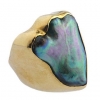
Price :
$11609.00
Although abalones are a fairly plentiful mollusk, these rock-hugging snails usually found in mild temperature ocean waters rarely produce pearls. When they do, the cause is More »
Although abalones are a fairly plentiful mollusk, these rock-hugging snails usually found in mild temperature ocean waters rarely produce pearls. When they do, the cause is usually an inner shell or intestinal disturbance anything from a tiny shell fragment or pebble to a parasite or small crab that requires encasement in a secretion. Over time this protective fluid hardens into a pearl, which sometimes has a hollow center because the original intruding substance has disintegrated. Like the magnificently iridescent shells in which they are found, abalone pearls such as this extraordinary example boast brilliant color play that makes them unique among this gem species. Indeed, one reason pearl connoisseurs have long made so much fuss over choice abalone pearls is the gems near opal like swirls and patches of rainbow colors among them, orange, red, yellow, blue and green. Off the coast of Mexico and California there are at least six different abalone types, classified by shell color, ranging from pink and red to green and black, not to mention other rarities off Japan, Korea, Thailand and South Africa. Today, the rocky shores of California and Mexico are the main source of abalone pearls, as they have been for a long time. When the Spaniards looted Mexico’s Aztec empire of its enormous gold, silver and gem wealth including abalone pearls in the early 16th century, this variety of pearl came into vogue in India, one of Spain’s trading partners. The wealthy Maharajahs who bought these pearls cherished the gems as truly prized possessions. Today, the abalone pearl continues to claim a high status in the realm of gems, for its distinctive beauty captivates the heart and soul of all who gaze upon this remarkable gift from the sea. - (FJ.5495)Origin: California Circa: 20 th Century AD Collection: Modern Jewelry Style: Contemporary Medium: Abalone Pearl, Gold « Less
|
|
Contemporary Designs
|
|
|
|
|
| Vendor Details |
Close |
| Contact Info : |
| Barakat Gallery |
| 405 North Rodeo Drive |
| Beverly Hills |
| California-90210 |
| USA |
| Email : barakat@barakatgallery.com |
| Phone : 310.859.8408 |
|
|
|
|
|
|
|
|

|


